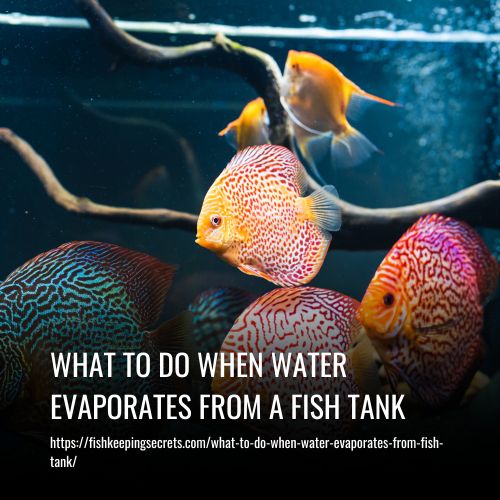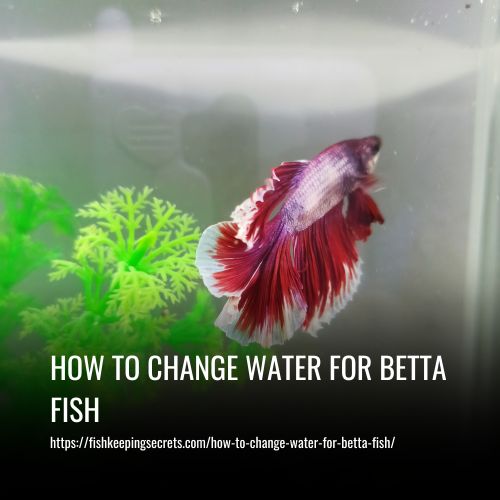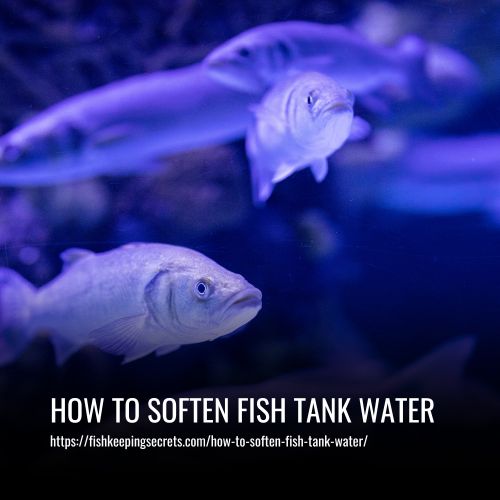Dealing with evaporation in a fish tank is a common issue for many aquarium owners. As water levels decrease, it’s important to understand how to properly address this issue to maintain a healthy aquatic environment for your fish.
When water evaporates from a fish tank, it’s important to take the following steps:
- 1. Regulate Water Temperature
- 2. Maintain Room Temperature
- 3. Use A Lid
- 4. Choose Your Fish Wisely
- 5. Change the Water Filter
- 6. Turn Off the Lights
- 7. Test the Water
- 8. Reduce Tank Size

What To Do When Water Evaporates From A Fish Tank
Aquarium evaporation is a natural process that cannot be completely stopped. However, there are ways to slow down the evaporation process.
1. Regulate Water Temperature
Maintain the water temperature at the cooler end to prevent excessive evaporation. High temperatures can increase evaporation and accelerate the fish’s metabolism, leading to elevated toxin levels in the tank. Be sure to monitor the temperature to prevent unexpected rises, which can cause stress to the fish and increase evaporation.
2. Maintain Room Temperature
Keep the room where the aquarium is located as cool as possible without being too cold. This helps prevent rapid evaporation. Dry air speeds up evaporation, so maintaining humidity in the room can be beneficial. Avoid placing the tank near sunny windows and consider using a cover to reduce light exposure and keep the tank cooler.
3. Use A Lid
Adding a glass lid to the aquarium reduces evaporation by creating a barrier between the water and the air. Condensation forms on the lid’s inside and drips back into the tank, slowing down the evaporation rate. A lid also helps maintain water temperature, prevents fish from jumping out, and keeps debris from falling into the tank.
4. Choose Your Fish Wisely
When selecting fish for your tank, consider their habitat preferences and temperature tolerance. If you live in a warm and dry climate, choose fish that thrive in cooler waters, such as goldfish, Bloodfin tetras, Rosy barbs, Buenos Aires tetras, Pearl Danios, or Zebra danios. These fish can withstand temperatures around the mid-60s Fahrenheit, allowing you to keep the room temperature at a comfortable level without impacting the fish.
5. Change the Water Filter
If your filter is old and clogged, it may be causing excessive heat and evaporation. Try cleaning or unclogging the filter. If the problem persists, consider getting a better filter to prevent excessive evaporation.
6. Turn Off the Lights
Lights generate heat, which increases evaporation. During the night, turn off all aquarium lights to reduce heat and conserve energy. Use high-efficiency, low-energy bulbs if necessary. If you use a lighting system to heat the tank, consider turning down the heater to minimize evaporation.
7. Test the Water
Regularly monitor the water temperature using a thermometer. Sudden increases in water temperature can lead to excessive evaporation. Use a thermometer that clips onto the tank or has a probe for accurate temperature readings.
8. Reduce Tank Size
Wider tanks have a larger surface area, leading to increased evaporation. If evaporation is causing issues with maintaining the water level, consider switching to a smaller tank and reducing the number of fish. This will help minimize evaporation and maintain water quality.
Implementing these measures can help minimize evaporation in your aquarium and create a healthier and more comfortable environment for your fish. Remember to always prioritize the well-being of your fish and regularly assess their behavior and overall health.
Why Does Water Evaporate from A Fish Tank
Understanding the factors that contribute to water evaporation in a fish tank is crucial for maintaining proper water levels and preventing potential issues. Here are the main factors that accelerate evaporation:
1. Warm Water
Heat is the primary catalyst for evaporation. As water temperature increases, the movement and collision of water molecules intensify. This energizes the molecules, allowing them to transform from liquid to gas more quickly, leading to evaporation.
2. Lack of Humidity
The lower the humidity of the surrounding air, the faster evaporation occurs. Dry air has more capacity to absorb water vapor, facilitating faster evaporation. While evaporation is generally faster in warm weather, dry conditions can also contribute to increased evaporation regardless of the season.
3. Air Movement
Air flow over the water’s surface plays a significant role in the rate of evaporation. When air moves across the surface, it carries away rising water vapor and further dries the air, promoting faster evaporation. This can occur naturally or be accelerated by using fans or other airflow devices to cool the water surface.
4. Moving Water Surface
Agitation of the water surface, such as through the use of air stones or Gyre pumps, increases the rate of evaporation. The ripples and movement of the water create a larger surface area, allowing more water molecules to escape as vapor.
By understanding these factors, fish tank owners can take measures to slow down evaporation and maintain the proper water levels in their tanks.
How Much Evaporation Is Normal for A Fish Tank
The rate of evaporation in a fish tank can vary depending on factors such as tank size, water conditions, and room temperature. In general, a standard 50-gallon saltwater tank can experience evaporation of approximately ½ gallon of water per day, requiring the addition of 3.5 gallons of purified water per week.
On the other hand, a 50-gallon freshwater aquarium tends to lose around a gallon of water each day. Saltwater tanks typically evaporate slightly slower than freshwater tanks due to the energy required to break apart dissolved salt ions for evaporation. It is important to monitor and replenish water levels in the tank to ensure a stable aquatic environment for your fish.
How to Measure the Amount of Water Lost Due to Evaporation
To estimate the water lost due to evaporation in your fish tank, start by marking the current water level with a piece of tape when you fill it up. After a couple of days, measure the difference in water level, and multiply it by the length and width of your tank. This will give you the amount of water evaporated in cubic inches.
To convert this measurement into gallons, you can use an online calculator. Generally, you can fill up your tank to about an inch or 1.5 inches below the rim. Keep in mind that evaporation rates may vary depending on factors such as temperature and humidity. Regularly monitoring and refilling your tank will help maintain a healthy environment for your fish.
How To Add More Water To A Fish Tank
Maintaining the proper water levels in your fish tank is essential for the health and well-being of your fish. Here are some methods to add more water to your fish tank:
1. Replacing Evaporated Water
Simply topping up the aquarium after water evaporation can be harmful to your fish. It can lead to the accumulation of pollutants like nitrate and phosphate, as well as a drop in alkalinity and pH levels. To avoid these issues, it is recommended to change 10% of the water every week or 25% every 2 weeks. This regular water change helps remove waste, prevent unwanted growth, and support your filter.
2. Manual Method
When adding water to your tank, it is crucial to use pure, demineralized water to prevent harmful chemicals from entering the tank and causing stress to the fish. If you don’t have access to pure water, you can make tap water safe by using water conditioners or treatments specifically designed for aquarium use. It’s best to store the treated water at room temperature for a few days before adding it to the tank to avoid sudden changes in the tank’s conditions.
3. Automatic Method
Using a semi-automated dosing pump is a convenient way to maintain proper water levels in your fish tank. These pumps are designed to pump small amounts of water into the tank, ensuring that the water levels don’t drop too low. A dosing pump can help prevent human error and ensure that you don’t forget to top up your tank.
Remember, maintaining the appropriate water levels in your fish tank is crucial for the health and happiness of your fish. Be mindful of the water quality and conditions to provide a thriving environment for your aquatic pets.
Problems Caused by Water Tank Evaporation
Water tank evaporation can lead to various problems that can negatively impact the health and well-being of your fish. It’s important to be aware of these issues and take appropriate action to prevent them. Some problems caused by water tank evaporation include:
1. Rising Ammonia Levels
Evaporation increases the concentration of ammonia in the tank, which is toxic to fish. This can lead to health problems and even poisoning if not addressed promptly. Signs of high ammonia levels include foul odor, gasping at the surface, motionless behavior, appetite loss, red or cloudy eyes, and redness around the gills. Regular water changes can help prevent and control ammonia buildup.
2. Increased Salinity
In saltwater tanks, evaporation leaves behind salts and minerals, causing the salinity to rise. Excessive salinity can dehydrate fish and damage their scales, potentially leading to death. Automatic top-off systems can help maintain consistent salinity levels.
3. Low Oxygen Levels
Evaporation reduces the oxygen levels in the tank, which can be detrimental to fish as they require dissolved oxygen to breathe. Symptoms of insufficient oxygen include gasping at the surface, lethargy, lack of appetite, and labored breathing. Adding more water, increasing aeration, and providing suitable substrate and plants can help improve oxygen levels.
4. Stressed Fish
Rapid evaporation without timely water replacement can result in decreased swimming space and overcrowding, leading to stress and subsequent behavioral changes in fish. Increased aggression, frantic swimming, hiding, surfing the glass, dimmer colors, and susceptibility to diseases are common signs of stressed fish. It’s crucial to maintain optimal water conditions and monitor evaporation levels to mitigate stress.
By understanding and addressing the problems caused by water tank evaporation, you can ensure the well-being and happiness of your fish. Regular water maintenance, monitoring water parameters, and providing a suitable environment are essential for maintaining a healthy aquatic ecosystem.
FAQs
Replacing the water in a fish tank when it evaporates is important because evaporation can lead to a decrease in water level, increase in water salinity and hardness, and concentration of fish waste and ammonia. These changes can be harmful to the fish and can cause stress, suffocation, and toxicity. Therefore, replacing evaporated water in a timely manner is necessary to maintain a healthy and balanced environment for the fish.
To determine how much water to fill in a fish tank, fill the tank to the desired level and mark it. After a week, measure the distance between the current water level and the marked level. Multiply this value by the width and length of the tank to calculate the water evaporation in milliliters for a week. Divide this number by seven to get the daily water loss. However, remember to recalculate this number when the seasons change as evaporation rates vary. Alternatively, you can estimate daily evaporation by subtracting 1% of the water’s temperature.
No, it is not possible to stop the water in a fish tank from evaporating completely. Evaporation is a natural process that will always occur. However, you can reduce the rate of evaporation by using a lid on your fish tank and keeping the tank away from light and heat sources.
While you can’t completely stop aquarium evaporation, there are several ways to slow it down. First, regulate the water temperature and keep it cooler to prevent excessive evaporation. Also, maintain the room temperature as cool as possible without being too cold to reduce evaporation. Using a lid on the aquarium can create a barrier between the water and air, reducing evaporation. Additionally, selecting fish that tolerate cooler waters can help minimize evaporation. Make sure to clean or unclog the water filter and consider turning off the lights at night to reduce heat and evaporation. Regularly monitor the water temperature and consider reducing the tank size if evaporation is causing issues.
While it is normal for the water level in a fish tank to decrease over a few days, a significant drop in just one or two days is cause for concern. Factors such as temperature, humidity, and water movements can contribute to rapid water evaporation. To address the issue, investigate and identify the root cause, then take appropriate steps to rectify it. This is an important part of maintaining a fish tank.
It is recommended to add water to your fish tank every week while doing a water change. In addition to the water change, you should also top off the water that is lost through evaporation. The amount of water to add depends on the size of your tank and the rate of evaporation.
The rate at which water evaporates depends on the humidity and temperature of the room. It is also influenced by the setup of the tank, such as the temperature of the water and the surface area exposed to the air. In a room with high temperatures and low humidity (below 40%), water levels in a fish tank may decrease every 2-3 days due to faster evaporation.
Freshwater evaporates faster than saltwater. This is because freshwater only contains water molecules on its surface, while saltwater contains both water and salt that take longer to evaporate. The salinity of the water in your fish tank can also affect the rate of evaporation.
Water evaporates at room temperature because there are water molecules in the liquid that have enough energy to escape into the air. These molecules with high kinetic energy break through the surface of the water and become vapor in the air, causing the water to evaporate. This process happens even at room temperature.
You can use a humidifier to slow down evaporation in your room if the humidity levels are too low. It can help balance the humidity levels and slow down evaporation, which can be beneficial for things like fish tanks or other items that require a certain level of moisture.
Conclusion
The evaporation of water from your fish tank is a common occurrence that can be easily managed if you take the necessary steps. Regularly monitoring the water level, topping up the tank with fresh water, and checking the water parameters are crucial to maintaining a healthy environment for your fish.
It’s also important to keep in mind that evaporation can be influenced by factors such as temperature, humidity, and air circulation. By understanding the causes and taking preventive measures, you can ensure that your fish tank remains a safe and comfortable home for your aquatic pets.



